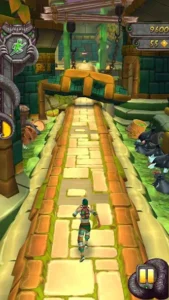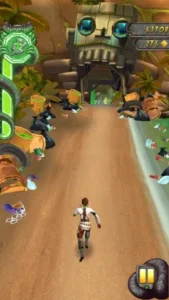Most mobile games fade into obscurity after a year or two. Yet here we are, twelve years after its launch, and Temple Run 2 still gets downloaded thousands of times daily.

Temple Run 2 with over 500 million installs and an 4.2-star rating from 11 million reviews, it’s clearly doing something right. But what keeps players coming back to this endless runner when there are flashier alternatives?
What Makes Temple Run 2 Special Today
Gameplay That Actually Feels Good
The swipe and tilt controls seem simple, but there’s genius in their execution:
-
Left/Right Swipes: Tight turns feel responsive, not slippery
-
Up/Down Gestures: Jumping and sliding have just the right weight
-
Tilt Controls: Surprisingly precise for coin collection
Pro Tip: New players should disable tilt at first – it’s easier to master swipe controls before adding the tilt dimension.
Environments With Personality
Each map isn’t just a reskin – they change how you play:
-
Jungle: The “starter” map with wide paths
-
Mines: Narrow tracks with deadly carts (the community’s most hated obstacle)
-
Ice Caves: Slippery physics that punish mistimed jumps
-
Temple: The original’s spiritual successor with tighter turns
Hardest Map? Mines, no contest. Those randomly appearing carts have ended more runs than players want to admit.
Characters That Actually Matter
Unlike many action runners where characters are just cosmetics, each runner in Temple Run 2 has unique perks:
-
Guy Dangerous (Default): Balanced stats
-
Scarlett Fox: Faster coin collection (best for beginners)
-
Barry Bones: Longer power up duration (high-score chaser’s pick)
-
Karma Lee: Rare gem magnet (saves grinding time)
Who to Unlock First: Scarlett Fox makes early game progression much smoother.
Power Ups Worth Your Coins
Not all upgrades are created equal:
-
Coin Magnet (Priority #1): Automatically grabs coins so you can focus on not dying
-
Shield (Priority #2): Survive one fatal hit per run
-
Score Booster: Only useful after mastering the basics
-
Head Start: Mostly a waste – better to practice the early sections
Visuals That Aged Surprisingly Well
From Pixelated to Polished
The original Temple Run (2011) looked like this:
-
Blocky textures
-
Flat lighting
-
Limited animations
Temple Run 2 (2013) brought:
-
Proper 3D models
-
Dynamic shadows
-
Weather effects (snow in ice caves, dust in mines)
Fun Fact: The mine cart sections still hold up visually because of their clever use of tunnel darkness and particle effects.
Why the UI Still Works
-
Minimal HUD: Just score, coins, and distance – no clutter
-
Clear Warnings: Obstacles always give visual/audio cues
-
Instant Restart: No lengthy death animations
What Players Say (The Good and Bad)
The Love
-
“Perfect for short breaks – just one more run turns into ten”
-
“My kids and I compete for high scores using the same account”
-
“The mine carts make me scream every time” (This is somehow positive)
The Frustrations
-
Gem Economy:
-
Too easy to burn through continues
-
Grinding for character unlocks feels slow
-
-
Ad Overload:
-
Forced ads after some deaths
-
Banner ads that sometimes obscure controls
-
-
Random Difficulty Spikes:
-
Some obstacle combinations feel unfair
-
Speed ramps up inconsistently
-
The Controversy
The game walks a line between:
-
Free Players: Can enjoy the core experience
-
Paying Players: Get quality of life improvements
Community Verdict: It’s not pay to win, but paying does reduce grind.
The Hidden Science Behind Temple Run 2
Physics: Why You Keep Wiping Out
The game’s speed isn’t constant – it follows a sneaky pattern:
-
0-500m: Warm up speed (easy mode)
-
500-2000m: Gradual 15% speed increase
-
2000m+: “Oh crap” mode where obstacles come 30% faster
Pro Tip: The mine cart section always triggers at the same distances – memorize these to anticipate rather than react.
Obstacle Patterns: There’s Actually Method to the Madness
While obstacles feel random, they follow set sequences:
-
Jungle Map: Tree roots → low branches → gap (repeat)
-
Mines: Left cart → right cart → low tunnel (the killer combo)
-
Ice Caves: Jump → slide → jump (timing gets tighter each cycle)
Survival Trick: Listen for audio cues – each obstacle has a distinct warning sound about 0.5 seconds before it appears.
Scoring: What Your Multiplier Actually Measures
Your score isn’t just about distance – it’s calculated by:
-
Base Points: 1 per meter
-
Multiplier: Increased by:
-
Coin streaks (collect 10+ without missing)
-
Near-misses (dodging obstacles at the last moment)
-
Power-up combos (using magnet + boost together)
-
Key Insight: A 2000m run with perfect multipliers beats a 3000m sloppy run.
How Temple Run 2 Stacks Up Against the Competition
| Feature | Temple Run 2 | Subway Surfers | Sonic Dash |
|---|---|---|---|
| Learning Curve | Moderate | Easy | Hard |
| Skill Ceiling | High (precise turns) | Medium (fast taps) | High (chaotic) |
| Reward System | Slow but fair | Fast with ads | Franchise heavy |
| Best For | Tactical players | Reflex gamers | Sonic fans |
Why Temple Run 2 Wins:
-
More strategic than it appears
-
No “paywall” for core gameplay
-
Genuine sense of progression
When to Play Alternatives:
-
Want something faster? Try Subway Surfers
-
Prefer licensed content? Sonic Dash
-
Like verticality? Minion Rush

Progression: From Noob to Leaderboard Crusher
Early Game (0-5 hours)
-
Upgrade Order:
-
Coin Magnet (level 3)
-
Shield (level 2)
-
Score Boost (level 1)
-
-
Character Unlock: Scarlett Fox first (her coin bonus accelerates progress)
-
Goal: Consistently hit 2000m runs
Mid Game (5-20 hours)
-
Gem Farming:
-
Complete daily challenges (3 free gems/day)
-
Watch optional ads (2 gems/day)
-
Save gems for Barry Bones (his power-up duration is game-changing)
-
-
Strategy: Practice mine cart sections until you can survive 5+ in a row
End Game (20+ hours)
-
Leaderboard Tactics:
-
Only play during 2x score events
-
Use score boost + coin magnet simultaneously
-
Master “danger runs” (intentional near-misses to boost multiplier)
-
-
Record: Top players average 15,000m+ (yes, really)
Why People Still Play After All These Years
Updates That Actually Matter
-
Seasonal Events: Halloween maps with pumpkin obstacles
-
New Characters: Still releasing 1-2 annually
-
Community Challenges: Global goals that unlock rewards
Social Features That Work
-
Leaderboards: Still active (top scores reset monthly)
-
Speedrunning Community: Niche but passionate (record is 4h 17m continuous play)
The Nostalgia Factor
For millennials, this was their first mobile game obsession – and the simple formula still holds up better than most 2025 releases.
Conclusion : Should You Still Play in 2025?
Yes, If:
-
You want quick 5 minute gaming sessions
-
Enjoy seeing tangible skill improvement
-
Like games that don’t demand hours daily
No, If:
-
Repetitive gameplay bores you fast
-
Can’t stand occasional ads
-
Want cutting-edge graphics
Temple Run 2 is like your favorite pair of jeans – not the flashiest option, but reliably comfortable when you need it. While newer runners have come and gone, this 2013 classic remains one of the few mobile games where skill truly matters more than spending money.
FAQ
Where can I download Temple Run 2?
Get it on Google Play Store or visit Imangi Studios’ site. For game history, check the Temple Run Wiki.
Which character should I unlock first in Temple Run 2?
Scarlett Fox (coin bonus) helps beginners, while Barry Bones (power-up duration) is better for high scores. Unlock them in this order for best progression.
How do I get more gems without paying?
Complete daily challenges (3 gems/day), watch optional ads (2 gems/day), and participate in seasonal events for bonus gems.
Why do my Temple Run 2 scores vary so much?
Scores depend on both distance AND multipliers. Focus on coin streaks and near-misses rather than just running far.
How do I stop Temple Run 2 ads?
Turn off mobile data/WiFi before launching (works for single-player), or pay the one-time fee to remove ads completely.

1 thought on “Temple Run 2 Secrets: What 500 Million Players Discovered (But You Might’ve Missed)”